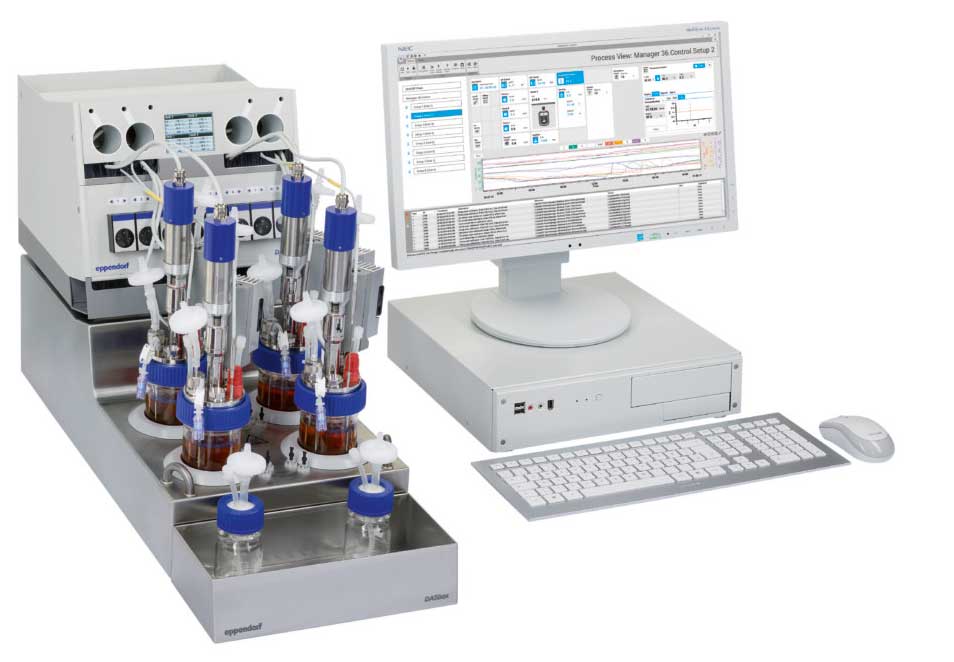
DASbox Mini Bioreactor System’s small working volumes and advanced control options offer a versatile solution for advanced process development experiments
Process development and optimization is a critical aspect of manufacturing for both cell culture and microbial-based systems. The challenge is often creating conditions in process development that match the conditions found in manufacturing. To fully optimize a process, it is important to be able to run multiple experiments at the same time in order to fully assess the best conditions. A Design of Experiments (DoE) provides an efficient and thorough look at a wide variety of conditions, but in order to fully utilize this tool, you must be able to conduct experiments in parallel. If not, the time and resources required would make DoE not feasible in many situations. If done properly, a good process development strategy can shorten a product’s time to market.
To meet these needs, Eppendorf provides the DASbox mini bioreactor system. The DASbox was designed to enable parallel operation to streamline process development and DoE, while still offering the advanced controls found in industrial bioreactors. It is suitable for microbial and cell culture applications including stem cell and gene therapy processes.
The DASbox System
The DASbox system offers an impressive amount of control in a compact footprint with only three inches (7.5 cm) of bench space required per bioreactor. The system is designed in blocks of four bioreactors with the option of running up to twenty-four bioreactors in parallel.

With working volumes of 60 – 250 mL and the ability to precisely control critical process parameters, the DASbox system provides technology that enables incorporation of DoE, Quality by Design (QbD), and Process Analytics Technology (PAT) found in advanced process development, screening, and media optimization studies. Other important features for advanced process development include high precision peristaltic pumps and off-gas analysis.
To enable PAT operations, control loops can be defined using external data as input, for example an external glucose analyzer could be added to control glucose concentration and feed. The optional integration and connectivity of other equipment supports sophisticated bioprocess information management.
Flexibility
The DASbox system is compatible with microbial and cell culture applications. In addition to using industry standard glass bioreactors, the DASbox can be equipped with BioBLU 0.3 Single-Use Bioreactors, all fully equipped single-use mini bioreactors. For stem cell applications, a new BioBLU Single-Use Bioreactor (BioBLU 0.3sc with 8-blade impeller) and a stem cell glass vessel, especially developed for stem cell process development, are available. The 8-blade impeller design used for these vessels keeps cells in suspension at low. In addition, the positioning of the dip tubes away from the vessel wall prevents clogging of cells.
Ease of use
The DASbox system’s designers have simplified operation with fast, easy set-up and several built in properties that ensure easy handling including:
- Parallel calibration of sensors and pumps
- Liquid-free temperature control and exhaust condensation
- A powerful scripting tool in the DASware control software suite
- In field upgrades of hardware and software
Precision Control
The system design has accounted for the precise control required in advanced process development applications. Temperature control is achieved by measuring inside and outside of the vessel. The DASbox can also run a two-sided pH control: acid/base or CO2/Base. Online graphs then provide online comparison of relevant process parameters like pH, DO, temperature and others. Straightforward comparison of historical data is also available by employing the synchronized inoculation time. Thereby, eliminating the need to manually align the different inoculation time points to compare data between the individual vessels or even historical runs. Each vessel also can be equipped with individual gas analysis, which provides the user with constant data for each vessel individually. Thus, enabling process control in real time.
Process safety
Powerful foam control has been integrated with level sensors that are able to activate the antifoam pump as soon as it comes in contact with foam. The sensor on the DASbox is very sensitive, thus providing a very accurate foam control. The level sensors also enable the automatic feed start and feed control features that will stop feeding the culture if the maximum vessel volume is reached.
The exhaust gas condensation means no clogging of the exhaust filter. In the case of a foam out, foam cannot enter the gassing device. If the filter gets clogged, the gassing devices automatically decreasing inlet gas down to keep the pressure below 0.5 bar. There is also built in overflow prevention with continuous monitoring of added liquid until the maximum working volume is reached.
The Dasbox provides all the same process controls of industrialized bioreactors and standard industry sensors to ensure scale up is more predictable. With easy workflow guidance on the one hand, and options to deeply adjust controller settings, the DASbox system is a great choice for beginners and experts alike.
Please see DASbox Mini Bioreactor System for additional details.